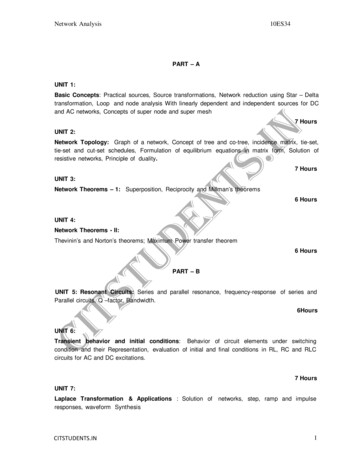
Transcription
CHAPTER 20ElectrochemistryOnline ChemistryHMDScience.comSection 2Voltaic CellsSection 3Electrolytic CellsOnline Labs include:Electric ChargeVoltaic CellsMicro-Voltaic CellsElectroplating for CorrosionProtectionPremium ContentWhy It Matters VideoHMDScience.comElectrochemistry(c) Jet Propulsion Laboratory/NASASection 1Introduction toElectrochemistry
Section 1Introduction toElectrochemistryKey Termselectrochemistryelectrodehalf-cellanodeMain IdeaElectrochemical cells separateoxidation reactions fromreduction reactions. cathodeOxidation-reduction reactions involve energy changes. Because these reactionsinvolve electron transfer, the net release or net absorption of energy can occur inthe form of electrical energy rather than as heat. This property allows for a greatmany practical applications of redox reactions. The branch of chemistry that dealsVirginia standardsCH.3 The student will investigate andunderstand how conservation of energy andmatter is expressed in chemical formulas andbalanced equations.CH.3.EKS-12with electricity-related applications of oxidation-reduction reactions is calledelectrochemistry.Main IdeaElectrochemical cells separate oxidation reactionsfrom reduction reactions.Oxidation-reduction reactions involve a transfer of electrons. If the twosubstances are in contact with one another, a transfer of energy as heataccompanies the electron transfer. In Figure 1.1 a zinc strip is in contactwith a copper(II) sulfate solution. The zinc strip loses electrons to thecopper(II) ions in solution. Copper(II) ions accept the electrons and fallout of solution as copper atoms. As electrons are transferred betweenzinc atoms and copper(II) ions, energy is released as heat, as indicated bythe rise in temperature.AfterBeforeFigure 1.1Temperature Change withElectron Transfer Energy asheat given off when electrons aretransferred directly from Zn atoms toCu2 ions causes the temperature ofthe aqueous CuSO4 solution to rise.Zinc stripCuSO4CuElectrochemistry617
Conducting wireFigure 1.2Electrochemical CellAn electrochemical cell consists of twoelectrodes. Each electrode is in contactwith an electrolyte; the electrode andthe electrolyte make up a half-cell. Thetwo electrodes are connected by a wire,and a porous barrier separates the twoelectrolytes.Zinc electrodeCopper electrodeCopper(II) sulfateElectrolyteZinc sulfateElectrolytePorous barrierAnodeCathodeIf, however, we separate the substance that is oxidized from thesubstance that is reduced, the electron transfer is accompanied by atransfer of electrical energy instead of energy as heat. One means ofseparating oxidation and reduction half-reactions is with a porous barrier,or salt bridge. This barrier prevents the metal atoms of one half-reactionfrom mixing with the ions of the other half-reaction. Ions in the twosolutions can move through the porous barrier, which keeps a chargefrom building up on the electrodes. Electrons can be transferred from oneside to the other through an external connecting wire. Electric currentmoves in a closed loop path, or circuit, so this movement of electronsthrough the wire is balanced by the movement of ions in solution.CHECK FOR UNDERSTANDINGIdentify In an electrochemicalcell, at which electrode doesoxidation take place? At whichelectrode does reduction take place?Altering the system in Figure 1.1 as just described would simply involveseparating the copper and zinc, as shown in Figure 1.2. The Zn strip is in anaqueous solution of ZnSO4. The Cu strip is in an aqueous solution of CuSO4.Both solutions conduct electricity, because they are electrolytes. Anelectrode is a conductor used to establish electrical contact with a nonmetallicpart of a circuit, such as an electrolyte. In Figure 1.2, the Zn and Cu strips areelectrodes. A single electrode immersed in a solution of its ions is a half-cell.The Half-CellsIn the half-cell that contains the Zn electrode in aqueous ZnSO4 solution, thehalf-reaction is Zn(s) Zn2 (aq) 2e-. The Zn metal loses two electronsto form Zn2 ions in solution, and therefore oxidation is taking place in thishalf-cell. The electrode where oxidation occurs is called the anode. In thehalf-cell that contains the Cu electrode in aqueous CuSO4 solution, thehalf-reaction is Cu2 (aq) 2e- Cu(s). In this half-reaction, the Cu2 ions in solution gain electrons to become Cu solid; that is, reduction is takingplace. The electrode where reduction occurs is called the cathode.618Chapter 20
The Complete CellRecall that oxidation cannot occur separately from reduction. Both mustoccur in an electrochemical reaction. The two half-cells taken togethermake an electrochemical cell. In the Zn/Cu electrochemical cell, theelectrons move from the Zn electrode through the wire and down the Cuelectrode to the Cu2 ions at the electrode-solution interface. The Cu2 ions are reduced to solid Cu, and the resulting Cu atoms attach themselves to the surface of the Cu electrode. For this reaction, a charge iscarried through the barrier by a combination of Zn2 (aq) ions movingfrom the anode to the cathode and the S O 24 (aq) ions moving from thecathode to the anode.An electrochemical cell may be represented by the following notation:anode electrode anode solution cathode solution cathode electrodeThe double line represents the salt bridge, or porous barrier, betweenthe two half-cells. For the present cell, the cell notation isZn(s) Zn2 (aq) Cu2 (aq) Cu(s)Figure1.3The Daniell Cell The light bulbis powered by the reaction in this cell.critical thinkingInfer What would happen if theporous barrier was removed frombetween the two electrodes?The electrochemical reaction can be found by adding the anodehalf-reaction to the cathode half-reaction. This overall (or net) reaction isthe following redox reaction:Zn(s) Cu2 (aq) Zn2 (aq) Cu(s)Although the two half-reactions occur at the same time, they occur atdifferent places in the cell. Thus, for the reaction to proceed, electronsmust pass through the wire that connects the two half-cells.An electrochemical cell that consists of the Zn and Cu reactiondescribed above is called the Daniell Cell, named for the English chemistJohn Frederick Daniell. The Daniell Cell can generate enough electricityto light up the light bulb shown in Figure 1.3. In electrochemical cells,either a chemical reaction produces electrical energy or an electriccurrent produces a chemical change.ElectrodesPorous barrierMC0SE20000051ASection 1 Formative ASSESSMENTReviewing Main Ideas1. Why is the use of a salt bridge or porous barriernecessary in an electrochemical cell?2. Given the Cu2 (aq) Cu(s) and Mg2 (aq) Mg(s)half-reactions, where Cu2 (aq) Cu(s) is thecathode reaction,a. write the overall reaction.b. write the cell notation.3. Write the half-reaction in which I-(aq) changesto I2(s). Would this reaction occur at the anodeor cathode?Critical Thinking4. RELATING IDEAS Is the net chemical resultof an electrochemical cell a redox reaction?Explain your answer.Electrochemistry619
Section 2Voltaic CellsMain IdeasBatteries and fuel cells are twotypes of voltaic cells.Exposure to water and oxygencauses iron to corrode.Key Termsvoltaic cellreduction potentialThe electric potential of avoltaic cell depends on thestrengths of the oxidizing andreducing agents. electrode potentialstandard electrode potentialVoltaic cells use spontaneous oxidation-reduction reactions to convert chemicalenergy into electrical energy. Voltaic cells are also called galvanic cells. The mostcommon application of voltaic cells is in batteries.Main IdeaBatteries and fuel cells are two types of voltaic cells.Virginia standardsCH.1.j The student will investigate andunderstand that experiments in which variablesare measured, analyzed, and evaluatedproduce observations and verifiable data. Keyconcepts include: the use of currentapplications to reinforce chemistry concepts.CH.3.EKS-12Figure 2.1 shows an example of a voltaic cell: the Zn Cu electrochemicalcell discussed in the previous section.Electrons given up at the anode pass along the external connectingwire to the cathode. The movement of electrons through the wire must bebalanced by the movement of ions in the solution. Thus, in Figure 2.1,sulfate ions in the CuSO4 solution can move through the barrier into theZnSO4 solution.The dry cells pictured in Figure 2.2 are common sources of electricalenergy. Like the wet cell previously described, dry cells are voltaic cells.The three most common types of dry cells are the zinc-carbon battery, thealkaline battery, and the mercury battery. They differ in the substancesbeing oxidized and reduced.e–Figure 2.1Voltaic Cell In a voltaic cell, electronsCopperstripZinc stripspontaneously flow from anode to cathode.The copper strip gains mass as copper ionsbecome copper atoms. The zinc strip losesmass as the zinc atoms become zinc ions.Zinc sulfate,ZnSO4, solutionZinc atom, ZnZinc ion,Zn2 Porous barriere–Copper(II) sulfate,CuSO4, solutione–Copperatom, Cue–Watermolecule,H2OAnode Sulfate ion, S O 2–4 Zinc atoms losing twoelectrons to become ions620Chapter 20CathodeCopperion, Cu2 Copper(II) ions gaining twoelectrons to become atoms
Zinc-Carbon Dry CellsFigure 2.2Batteries such as those used in flashlights are zinc-carbon dry cells. Thesecells consist of a zinc container, which serves as the anode, filled with amoist paste of MnO2, carbon black, NH4Cl, and ZnCl2, as illustrated inFigure 2.3a. When the external circuit is closed, zinc atoms are oxidized atthe negative electrode, or anode.0Batteries Many common batteriesare simple voltaic dry cells.Alkalinebatteries 2 Zn (s) Zn 2 (aq) 2e-Zinc carbonbatteriesElectrons move across the circuit and reenter the cell through the carbonrod. The carbon rod is the cathode or positive electrode. Here MnO2 isreduced in the presence of H2O according to the following half-reaction. 3 4 2Mn O2(s) H2O(l) 2e- Mn 2O3(s) 2OH-(aq)MercurybatteryAlkaline BatteriesThe batteries found in a portable compact disc player or other smallelectronic device are frequently alkaline dry cells. These cells do not have acarbon rod cathode, as in the zinc-carbon cell. The absence of the carbonrod allows them to be smaller. Figure 2.3b shows a model of an alkalinebattery. This cell uses a paste of Zn metal and potassium hydroxide insteadof a solid metal anode. The half-reaction at the anode is as follows.0 Zn (s) 2OH-(aq) 2 Zn (OH)2(s) 2e-The reduction half-reaction, the reaction at the cathode, is exactly thesame as that for the zinc-carbon dry cell.Figure 2.3Zinc and Alkaline Dry CellsCarbon rod(cathode)CRITICAL THINKINGDistinguish What isthe difference between azinc-carbon dry cell and analkaline battery?SpacerZinc oltaic CellZn-KOHanode pasteBrass currentcollectorKOHelectrolyteSpacerMnO2,cathode mixSteel jacketMoist electrolytic paste of ZnCl2,MnO2, NH4Cl, and carbon black(a) Zinc Dry Cell In a zinc dry cell, zinc is oxidized to Zn2 at the anode, and manganese(IV) isreduced to manganese(III) at the cathode.(b) Alkaline Dry CellKOH makes the electrolyte paste inthis battery basic. Thus, it is called analkaline dry cell.Electrochemistry621
Zn in KOH (anode)Figure 2.4Mercury Batteries It is important thatSteel jacketmercury batteries be recycled and not justdiscarded because mercury is a poi son oussubstance.SeparatorHgO, carbon (cathode)Mercury BatteriesThe tiny batteries found in hearing aids, calculators, and camera flashesare mercury batteries, as shown in Figure 2.4. The anode half-reaction isidentical to that found in the alkaline dry cell. However, the cathode, orreduction, half-reaction is different. The cathode half-reaction is describedby the following equation. 20HgO (s) H2O(l) 2e- Hg (l) 2OH-(aq) Fuel CellsA fuel cell is a voltaic cell in which the reactants are being continuouslysupplied and the products are being continuously removed. Therefore,unlike a battery, a fuel cell could, in principle, work forever, changingchemical energy into electrical energy.Fuel cells based on the reactions listed below and shown in Figure 2.5are used in the United States space program.Cathode: O2(g) 2H2O(l) 4e- 4OH-(aq)Anode: 2H2(g) 4OH-(aq) 4e- 4H2O(l)Net reaction: 2H2 O2 2H2OFuel cells are very efficient and have very low emissions.Excess H 2 (g) H 2 O(g)Excess O2 (g) H 2 O(g)Figure 2.5Fuel Cells The reactions in this fuelcell take place at carbon electrodes thatcontain metal catalysts. The water formedis removed as a gas.H 2 (g)OHPorous graphiteanodeChapter 20e–O2 (g)K critical thinkingAnalyze Why would a fuel cell haveless of an impact on the environmentthan other types of cells?622e–Electrolyte solutionPorous graphitecathode
Main IdeaExposure to water and oxygen causes iron to corrode.Corrosion is an electrochemical process that has a large economicimpact. Approximately 20% of all the iron and steel produced is used torepair or replace corroded structures. One of the metals most commonlyaffected by corrosion is iron. Rust, hydrated iron(III) oxide, forms by thefollowing overall reaction.4Fe(s) 3O2(g) xH2O(l) 2Fe2O3 xH2O(s)The amount of hydration of the iron oxide, noted by the coefficient xin the equation above, varies, and affects the color of the rust formed.The mechanism for the corrosion of iron contains the followingelectrochemical reactions.Anode: Fe(s) Fe2 (aq) 2eCathode: O2(g) 2H2O(l) 4e- 4OH-(aq)The anode and cathode reactions occur at different regions of the metalsurface. The electric circuit is completed by electron flow through themetal itself, which acts like the wire in an electrochemical cell. The wateron the surface of the metal serves as the salt bridge. Thus, for corrosion tooccur, water and oxygen must be present with the iron.check for understandingExtend Express the process of rustingin electrochemical cell notation.As shown in Figure 2.6, when the iron is exposed to water and oxygen,the iron metal at the anodic site is oxidized to Fe2 ions. The electronsreleased at this site travel along the metal (like the wire of a cell) to thecathodic region, where oxygen is reduced. The Fe2 ions travel along themoisture toward the cathodic regions. At the cathode, the Fe2 ions arefurther oxidized to Fe3 ions and form rust, which is hydrated iron oxide,Fe2O3 xH2O.2Fe2 (aq) (3 x)H2O(l) Fe2O3 xH2O(s) 6H (aq) 2e-Figure 2.6Water molecule, H 2 OElectrochemical Explanation ofRusting The cathodic reaction happens whereOxygen molecule, O2Iron(II) ion, Fe 2 the O2 concentration is high. The anodic reactionhappens in a region where the O2 concentration islow, such as a pit in the metal.Hydroxide ion, OHCathodic site:O (aq) 2H O(l) 4e-Anodic site:Fe(s)2e- Fe2 (aq)224OH- (aq)PaintIron, FeWater layerIon conductionRusteElectron conductionElectrochemistry623
Figure 2.7Sacrificial Anode The Alaskanpipeline is cathodically protected bya parallel zinc cable.Preventing CorrosionThe presence of salt or high acidity speed the corrosion process, becausethe movement of electrons is facilitated by the extra ions present.How can corrosion be prevented? One way, which makes use ofelectrochemical properties of metals, is to coat steel with zinc in a processcalled galvanizing. Zinc is more easily oxidized than iron; therefore, zincwill react before the iron is oxidized. This is called cathodic protection,and the more easily oxidized metal used is called a sacrificial anode.The Alaskan oil pipeline, shown in Figure 2.7, is an example of steel that iscathodically protected. However, instead of coating, zinc is connected to thepipe by a wire. The zinc will oxidize before the iron in the steel does. As thezinc anode corrodes, it gives electrons to the cathode, the steel, and as thezinc anode does so, it prevents the steel from corroding. As the zinc dissolves, it needs to be replaced. As long as zinc metal that is able to corrode ispresent, the steel will be protected from corrosion.Main IdeaThe electric potential of a voltaic cell depends on thestrengths of the oxidizing and reducing agents.In a voltaic cell, the oxidizing agent at the cathode pulls the electronsthrough the wire away from the reducing agent at the anode. The “pull,”or driving force on the electrons, is called the electric potential. Electricpotential, or voltage, is expressed in units of volts (V), which is thepotential energy per unit charge. Current is the movement of the electrons and is expressed in units of amperes, or amps (A).Electrical potential is analogous to gravitational potential. Just aswater flows from a position of higher gravitational potential to a positionof lower gravitational potential, electrons flow from higher electricalpotential to lower electrical potential.Electrode PotentialsReconsider the voltaic cell shown in Figure 2.1. There are two electrodes,Zn and Cu. These two metals each have different tendencies for acceptingelectrons. This tendency for the half-reaction of either copper or zinc to occurplaced in a solution of ZnSO4 and a strip of copper placed in a solution ofCuSO4. The difference in potential between an electrode and its solution isknown as electrode potential. When these two half-cells are connected andthe reaction begins, a difference in potential is observed between theelectrodes. This potential difference, or voltage, is proportional to theenergy required to move a certain electric charge between the electrodes.A voltmeter connected across the Zn Cu voltaic cell measures a potentialdifference of about 1.10 V when the solution concentrations of Zn2 andCu2 ions are each 1 M.624Chapter 20 Brown W. Cannon III/The Image Bank/Getty Imagesas a reduction half- reaction in an electrochemical cell can be quantified as areduction potential. There are two half-cells in Figure 2.1: a strip of zinc
The potential difference measured across the complete voltaic cell iseasily measured and equals the sum of the electrode potentials for thetwo half- reactions. Individual electrode potential cannot be meas ureddirectly, because there can be no transfer of electrons unless both theanode and the cathode are connected to form a complete circuit. Arelative value for the potential of a half-reaction can be determined byconnecting it to a standard half-cell as a reference. This standard halfcell, shown in Figure 2.8, is called a standard hydrogen electrode, or SHE.It consists of a platinum electrode dipped into a 1.00 M acid solutionsurrounded by hydrogen gas at 1 atm pressure and 25 C. Other electrodesare ranked according to their ability to reduce hydrogen in the SHE.The anodic reaction for the standard hydrogen electrode is describedby the forward half-reaction in the following equilibrium e quation.0 1 2H (aq) 2e H 2(g) The cathodic half-reaction is the reverse. An arbitrary potential of 0.00 Vis assigned to both of these half-reactions. The potential of a half-cell underFigure 2.8Standard HydrogenElectrode (SHE) A hydrogenelectrode is the standard referenceelectrode for measuring electrodepotentials. The electrode surface incontact with the solution is actually alayer of hydrogen adsorbed onto thesurface of the platinum.critical thinkingEvaluate What is the advantage ofusing a standard electrodecompared to all other electrodes?H2(g)standard conditions measured relative to the standard hydrogen electrode is astandard electrode potential, E0. Electrode potentials are expressed aspotentials for reduction, which provide a reliable indication of the tendency of a substance to be reduced. Figure 2.9 shows how the SHE is usedto find the electrode potentials of the zinc and copper half‑cells. Halfreactions for some common electrodes and their standard electrodepotentials are listed in Figure 2.10 on the next page.Effective oxidizing agents, such as Cu2 and F2, have positive E0values. Half-reactions with negative reduction potentials prefer oxidationover reduction. Effective reducing agents, such as Li and Zn, havenegative E0 values, indicating that the metal or other electrode is morewilling to give up electrons than hydrogen.Pt wireH2(g)Pt blackelectrodeWhen a half-reaction is written as an oxidation reaction, the sign of itselectrode potential is reversed, as shown for the half-reactions for zinc.Zn2 2e- Zn E0 -0.76 VZn Zn2 2e- E0 0.76 VThe potential difference across the zinc/hydrogen cell is -0.76 V, sozinc is considered to have an electrode potential of -0.76. The negativenumber indicates that electrons flow from the zinc electrode, where zincis oxidized, to the hydrogen electrode, reducing aqueous hydrogen ions.Figure 2.9Finding Electrode PotentialsThe electrode potentials of zinc and copperhalf-cells are measured by coupling themwith a standard hydrogen electrode.Zinc strip,ZnCopperstrip, CuElectrochemistry625
Figure 2.10Standard Reduction PotentialsHalf-cell reactionStandard electrodepotential, E0 (in volts)Half-cell reactionStandard electrodepotential, E0 (in volts) 2FF2 2e - 2.87 FeFe3 3e - -0.04 Mn2 4H OMn O 4 8H 5e - 2 1.49 PbPb2 2e - -0.13 AuAu3 3e - 1.42 SnSn2 2e - -0.14 2ClCl2 2e - 1.36 NiNi2 2e - -0.23 2Cr3 7H O 7 14H 6e - Cr2 O 22 1.33 CoCo2 2e - -0.28 Mn2 2H OMnO2 4H 2e - 2 1.21 CdCd2 2e - -0.40 2BrBr2 2e - 1.07 FeFe2 2e - -0.41 HgHg2 2e - 0.85 S2S 2e - -0.51 AgAg e - 0.80 CrCr3 3e - -0.74- H g 2 2 2e 2Hg 0.80 ZnZn2 2e - -0.76 Fe2 Fe3 e - 0.77 AlAl3 3e - -1.66 Mn O 2 Mn O 4 e - 4 0.56 MgMg2 2e - -2.37 2II2 2e - 0.54 NaNa e - -2.71 CuCu2 2e - 0.34 CaCa2 2e - -2.76 Cu Cu2 e - 0.16 BaBa2 2e - -2.90 H S(aq)S 2H (aq) 2e - 2 0.14 KK e - -2.930.00 LiLi e - -3.04 H2H (aq) 2e - 2A copper half-cell coupled with the standard hydrogen electrode givesa potential difference measurement of 0.34 V. This positive number indicates that Cu2 (aq) ions are more readily reduced than H (aq) ions.Standard electrode potentials can be used to predict if a redox reactionwill occur spontaneously. A spontaneous reaction will have a positivevalue for E0cell, which is calculated using the following equation.E0cell E0cathode - E0anodeCHECK FOR UNDERSTANDINGCompare How is subtracting thevalue the for the half-cell reaction atthe anode the same as reversing thereaction?626Chapter 20The half-reaction that has the more negative standard reduction potentialwill be the anode. Oxidation occurs at the anode, so the anode half-cellreaction will be the reverse of the reduction reaction found in Figure 2.10.Thus, the total potential of a cell is calculated by subtracting the standardreduction potential for the reaction at the anode (E0anode) from thestandard reduction potential for the reaction at the cathode (E0cathode).
Premium ContentCalculating Cell PotentialsLearn It! VideoSample Problem A Write the overall cell reaction, and calculate thecell potential for a voltaic cell consisting of the following half-cells: aniron (Fe) electrode in a solution of Fe(NO3)3 and a silver (Ag) electrode ina solution of AgNO3.Solve It! CardsAnalyzeHMDScience.comHMDScience.comGiven: A half-cell consists of Fe(s) withFe(NO3)3(aq) and a second half-cell consists of Ag(s) with AgNO3(aq).Unknown:E 0cell 1. Look up E0 for each half-reaction (written as reductions) in Figure 2.10.PLANFe3 (aq) 3e- Fe(s) E0 -0.04 V Ag (aq) e- Ag(s)E0 0.80 V2. Determine the cathode and anode.Fe in Fe(NO3)3 is the anode because it has a lower reduction potential thanAg. Ag in Ag(NO3) is therefore the cathode.1. Determine the overall cell reaction. Multiply the Ag half-reaction by 3 sothat the number of electrons lost in that half-reaction equals the number ofelectrons gained in the oxidation of iron. Reverse the iron half-reaction tobe an oxidation half-reaction.Solve3Ag (aq) Fe(s) 3Ag(s) Fe3 (aq)2. Calculate the cell potential by E 0cell E 0cathode - E 0anode. Note that when ahalf-reaction is multiplied by a constant, the E 0 value is not multiplied bythat constant but remains the same.E 0cell E 0cathode - E 0anode 0.80 V - (-0.04 V) 0.84 VCHECK YOURWORKThe calculated value for E 0cell is positive, which confirms that it is a voltaic cell,as the problem states.Answers in Appendix E1. For each pair of half-cells, determine the overall electrochemical reaction that proceedsspontaneously and the E0 value. 7 /Cr3 and Ni2 /Nia. Cr2 O 2 b. SHE and Fe2 /Fe3 Section 2 Formative ASSESSMENTReviewing Main Ideas1. What is a voltaic cell?2. What is electrode potential, and how is it usedto calculate information about an electrochemical cell?3. Given the Na /Na and K /K half-cells,determine the overall electrochemical reactionthat proceeds spontaneously and the E0 value.4. Given the MnO2/Mn2 and Cr3 /Cr half-cells,determine the overall electrochemical reactionthat occurs spontaneously and the E0 value.Critical Thinking5. evaluating ideas A sacrificial anode isallowed to corrode. Why is the use of a sacrificial anode considered to be a way to preventcorrosion?Electrochemistry627
why it mattersFuel-Cell CarsThe technology currently favored for automobiles is theproton-exchange membrane (PEM) fuel cell. The system worksby combining hydrogen with oxygen taken from the outsideair. The movement of the electrons (produced by a redoxreaction) along an external route generates electricity, which isused eventually to turn the car wheels. The process is two tothree times more efficient than that of the internal-combustionengine, and the only products are water and a moderateamount of energy as heat. In most cases, a traditional carbattery is used to operate the car’s electrical system.In principle, fuel cells can run on any hydrogen-rich fuel.Several candidate fuels that can power fuel cells are beinginvestigated: methanol, ethanol, natural gas, gasoline, andliquid or compressed hydrogen. If the fuel is not hydrogengas, the engine needs to include a reformer that can convertthe other fuel (such as methanol) to hydrogen.The range of fuel-cell powered cars is limited by the amountof fuel that can be stored in the storage tank. Current storagetechnology can take the cars to 300 miles or more beforerequiring refueling. Researchers in this area are looking intocarbon-adsorption systems, which are refrigerated andpressurized tanks that can store large amounts of hydrogen.Hydrogen is very combustible, but safe hydrogen tanks havebeen developed.Eventually,fuel-cell carssuch as thisone mayreplacegasolinepowered cars.628So today, the experts do not have any more concern aboutthe safety of hydrogen storage than they do about gasolinestorage.However, the landscape is not yet dotted with hydrogenrefueling stations. Current experimental users such asgovernmental institutions must have their own hydrogenrefueling stations. Auto companies say there needs to be aconsumer infrastructure for the hydrogen fuel-cell carsbefore consumers will buy. On the other hand, possibledevelopers of such hydrogen stations say that there needs tobe a demand before the infrastructure can form.The use of fuels such as methanol solves the storage andfuel infrastructure problem, because these fuels can bestored similar to the way gasoline is stored. Therefore, thesefuels can be sold at current gasoline stations.One should also consider the emissions and energy useinvolved in making and delivering the hydrogen fuel inaddition to the emissions from the hydrogen fuel cell.Producing hydrogen fuel itself could involve substantialemissions. Even so, fuel-cell cars are still more efficient andhave greater environmental benefits than the internalcombustion cars of today.Currently, all major car companies are developing andresearching fuel-cell cars. Most companies have prototypecars and some cars are in use by governmental institutions.Which type will ultimately succeed in the mass market is yetunknown. Experts agree, though, that for zero-emission cars,hydrogen is the only major fuel option that has beenidentified to date.Questions1. Fuel cells that use hydrogen as fuel produce water andmoderate amounts of energy in the form of heat as theonly emissions. What kinds of negative effects mightcars that use hydrogen-rich fuels have on theenvironment?2. I n the PEM fuel cell, the hydrogen ions are produced atwhich electrode: the anode or cathode? Getty ImagesThe car of the future is quiet, has low emissions, andrequires less maintenance than cars of today do. Theseare the promises of fuel-cell cars. The development offuel-cell cars has been pushed by state and federal programs,legislation, and funding. There are a number of issues thatneed to be resolved before the large-scale manufacture offuel-cell cars becomes feasible. These include the fuel- storagecapacity of the car, and the fueling infrastructure.
Section 3Electrolytic CellsMain IdeasNonspontaneous redoxreactions occur in electrolyticcells.Key Termselectrolytic cellelectroplatingElectrolysis uses electricalenergy to cause anonspontaneous chemicalreaction to occur.electrolysisSome oxidation-reduction reactions do not occur spontaneously but can bedriven by electrical energy. If electrical energy is required to produce a redoxreaction and bring about a chemical change in an electrochemical cell, it is anelectrolytic cell. Most commercial uses of redox reactions make use ofelectrolytic cells. Virginia standardsCH.3 The student will investigate andunderstand how conservation of energy andmatter is expressed in chemical formulas andbalanced equations.CH.3.EKS-12Main IdeaNonspontaneous redox reactions occurin electrolytic cells.A comparison of electrolytic and voltaic cells can be seen in Fig
HMDScience.com Premium Content Zinc-Carbon Dry Cells Batteries such as those used in flashlights are zinc-carbon dry cells. These cells consist of a zinc container, which serves as the anode, filled with a moist paste of MnO 2, carbon black, NH 4 Cl, and ZnCl 2, as illustrated in Figure 2.3a. When the external circuit is closed, zinc atoms are .










